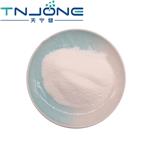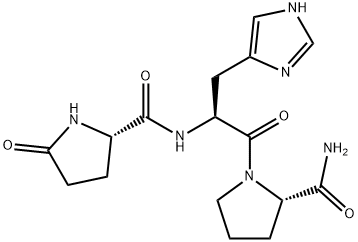- Protirelin
-

- $0.00 / 100g
-
2024-04-17
- CAS:24305-27-9
- Min. Order: 1g
- Purity: 99%
- Supply Ability: 100kg
|
| Product Name: | Thyrotropin-releasing hormone | | Synonyms: | synthetictsh-releasinghormone;THYROTROPIN RELEASING HORMONE ACETATE TE;PGLU-HIS-PRO AMIDE ACETATE F & D VERSIO;GLP-HIS-PRO-NH2;H-PGLU-HIS-PRO-NH2;L-PYROGLUTAMYL-L-HISTIDYL-L-PROLINAMIDE;THYROLIBERIN;THYROTROPIN RELEASING HORMONE 1-2 | | CAS: | 24305-27-9 | | MF: | C16H22N6O4 | | MW: | 362.38 | | EINECS: | 246-143-4 | | Product Categories: | Peptide;THYPINONE | | Mol File: | 24305-27-9.mol |  |
| | Thyrotropin-releasing hormone Chemical Properties |
| Melting point | >143°C (dec.) | | alpha | -50 (D/25℃) (c=1.5, H2O)-65.5 (D) (c=1.0, H2O) | | Boiling point | 494°C (rough estimate) | | density | 1.1675 (rough estimate) | | refractive index | 1.6000 (estimate) | | storage temp. | −20°C | | solubility | H2O: 10 mg/mL, clear, colorless | | pka | 13.05±0.20(Predicted) | | form | powder | | color | White to Off-White | | PH | pH (10g/l, 25℃) : 3.0~4.0 | | Merck | 13,9663 | | BRN | 770238 | | Stability: | Hygroscopic | | InChIKey | ITYONPBTNRIEBA-SRVKXCTJSA-N | | CAS DataBase Reference | 24305-27-9 |
| | Thyrotropin-releasing hormone Usage And Synthesis |
| Discovery | TRH was first isolated and characterized in 1969 by
Roger Guillemin and Andrew Schally, who shared the
Nobel Prize in Physiology or Medicine in 1977 “for their
discoveries concerning the peptide hormone production
of the brain.”The biosynthesis of TRH from a precursor molecule was first clarified in 1984 by isolation of a
preproTRH cDNA from the skin of Xenopus laevis. The
structure of the TRH receptor (TRH-R) was first deduced
from a cDNA isolated from the mouse pituitary in 1990. | | Properties | Mr 362. Soluble in water, methanol, and ethanol; partially insoluble in chloroform; completely insoluble in
ether and pyridine. Stable in solution at <15°C for more
than a year; partially (1%) degraded at 40°C for 6 months.
Resistant to proteolytic enzymes. Inactivated by diazotized sulfanilic acid (Pauly reagent). Plasma half-life is
2–6min. | | Synthesis and release | TRH secretion is regulated by norepinephrine, histamine, dopamine, and serotonin. Cold-induced secretion
of TSH from the rat anterior pituitary involves
α-adrenergic regulation of TRH secretion. TRH neurons
in the PVN are negatively regulated by thyroid hormones
through a feedback mechanism. Locally produced T3 is
taken by these neurons to regulate transcription, posttranslational modification, and degradation of TRH. | | Gene, mRNA, and precursor | TRH is synthesized from a precursor that contains
multiple copies of the TRH progenitor sequence GlnHis-Pro-Gly, which is flanked by dibasic cleavage sites
at its N- and C-termini. The number of progenitor sequences in a precursor is diversified: six in humans,
five in rats, four in chicken, seven in frogs, and six to eight
in fish. Human preproTRH gene, TRH, location 3q13.3–q21, consists of three exons. | | Clinical implications | The majority of thyroid disfunction is due to primary
thyroid disease. On the other hand, central thyroid disfunction is related to a disorder of the pituitary (TSH),
hypothalamus (TRH), or hypothalamic-pituitary portal
circulation. Isolated central hypothyroidism was
reported in a patient with inactivating mutations in the
TRH-R gene. | | Receptors | TRH-R is a seven-transmembrane-domain GPCR. Two
major types of TRH-Rs (type I receptor including TRH-R1
and TRH-R3, and type II receptor [TRH-R2]), have been
identified in vertebrates . Three and four subtypes of TRH-Rs have been identified in Xenopus laevis
and teleost species, respectively. TRH action is mediated via a membrane receptor
mainly coupled to Gq/11 protein. TRH induces the mobi�lization of intracellular Ca2+ and the activation of PKC in
target cells. | | Biological functions | The Trh knockout mice show normal development,
but exhibit tertiary hypothyroidism and hyperglycemia
due to diminished insulin secretion. The Trh knockout
mice show defects in cerebellar long-term depression
and a motor learning deficit.The Trhr1 knockout mice
exhibit central hypothyroidism showing a decrease in
serum T3, T4, and PRL levels but not in serum TSH levels. The Trhr1 knockout mice exhibit normal growth
and development but displayed increased anxiety and
depression levels. The Trhr2 knockout mice are euthyroid with normal serum TSH levels and exhibit normal
development and growth. The mutant females exhibited
moderately increased depression and reduced anxiety
phenotypes. | | Description | The first hypothalamic hypophysiotropic neurohormone
identified, TRH consists of the tripeptide pGlu-His-ProNH2. It stimulates the secretion ofthyroid-stimulating hormone
(TSH), prolactin (PRL), and growth hormone (GH), and also
functions as a neurotransmitter and neuromodulator. | | Chemical Properties | White or yellowish-white powder, hygroscopic. | | Uses | prothyrotropin | | Uses | Thyrotropin-Releasing Hormone is a hypothalamic hypophysiotropic neuropeptide, which has the ability to stimulate the release of thyroid-stimulating hormone in mammals. It is proven that Thyrotropin-Releasing Hormone can be used to accelerate wound healing. | | Indications | Thyrotropin-releasing hormone, or protirelin, consists
of three amino acids. TRH (Relefact TRH) is used for
tests to distinguish primary from secondary hypothyroidism. | | Definition | ChEBI: Protirelin is a tripeptide composed of L-pyroglutamyl, L-histidyl and L-prolinamide residues joined in sequence. It has a role as a human metabolite. It is a peptide hormone and a tripeptide. | | General Description | Thyrotropin releasing hormone (TRH) is a tripeptide hypothalamic regulatory hormone, encoded by the gene mapped to human chromosome 3q13.3-q21. TRH is expressed in a variety of organs including central nervous system (CNS) and gastrointestinal tract. | | Biochem/physiol Actions | Thyrotropin releasing hormone (TRH) stimulates production and secretion of thyrotropin (TSH) and prolactin from the anterior pituitary. It also plays a vital role as a neurotransmitter and neuromodulator. | | Clinical Use | TRH (200–500μg) administered intravenously to normal subjects causes a rise in TSH levels within
15–30min, resulting in an increase in T3 levels within
90–150min. In primary hypothyroidism, TSH hyperresponse to TRH occurs, with a typical elevation in the
basal TSH levels. In secondary (pituitary) hypothyroidism, an impaired TSH response to TRH occurs, whereas
in tertiary (hypothalamic) hypothyroidism normal or
increased TSH response to TRH occurs. Protirelin is used
to test the response of the anterior pituitary to TRH in
people who may have medical conditions of thyroid
function, including hyperthyroidism, Graves’ disease,
and hypothyroidism. In addition, TRH has been used
to assess the ability of the prolactin secretion in the
pituitary. | | Side effects |
The peak TSH response to intravenous TRH occurs at 20 minutes. The mild and transient side effects, which occur only after intravenous TRH, include nausea, a flushing sensation, a desire to micturate, a peculiar taste, and tightness in the chest[1].
|
| | Thyrotropin-releasing hormone Preparation Products And Raw materials |
|